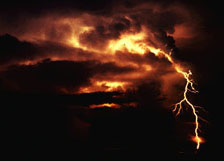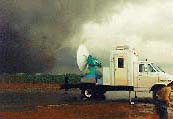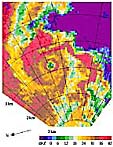
|


|
One thing that many people don't realize is that scientists and researchers still don't know exactly what causes tornadoes and severe storms. There are many hypotheses and a good understanding of certain factors, but exactly what causes a tornado and the ability to accurately predict severe storms are topics which scientists are actively studying today.
|

Visualization: The New Tools

When people talk about severe storm "visualization" tools they are referring to the new methods for creating pictures out of information. For example, scientists have begun to use images created by doppler radar to study the structure of tornados. These new tools take advantage of computers and graphics technologies which have only recently become available and affordable to scientists.
|

The "Doppler on Wheels" is a mobile tornado guage
housed in a van for speedy on-site tracking
|

|
Now, new tools in remote sensing have allowed scientists to gather large amounts
of information about storms. Powerful new supercomputers help scientists process
the data and display it in a visual model. Visual models are
often easier for scientists and researchers to understand: patterns that might be hard to see when
looking at page after page of numbers can quickly make sense when a computer creates a "picture" of the data.
|
However, there is much that is still unknown about storms. Scientists do not yet
understand all the causes and behaviors of violent and damaging storms such as tornados
and hurricanes.
Tips for Teachers

To prepare for a live conversation with the scientists, teachers can talk with their students about
storms. Do you have ideas about how thunderstorms happen? What about tornados? You
might explore some of the various weather and severe storm sites on the Web.
If you check the
calendar
to find out which expert you are going to be talking with,
you can focus on her/his particular specialty.
Then start generating questions. Write them all down; simple questions can actually turn out to be great questions. Scientists are still exploring some of the
most basic questions about storms. The new visualization tools are yeilding new twists to these questions, and
in some cases, new answers.
|

|
Two images generated from a storm tracked by the
Doppler on Wheels


|
|







